Unilever Case Study: Managing a Successful Business Project Report
VerifiedAdded on 2023/01/12
|25
|5678
|36
Report
AI Summary
This report delves into the critical aspects of project management, focusing on strategies to foster an inclusive and diverse workforce within an organization, using Unilever as a case study. The report begins by outlining the project's aims and objectives, emphasizing the importance of creating a healthy and friendly working environment where all employees, regardless of their differences, can contribute effectively. It then details the project management plan, including cost, time, scope, resources, communication, risk assessment, and quality control. Key project management tools like Gantt charts and Work Breakdown Structures (WBS) are also discussed. The report includes a small-scale research component, exploring both quantitative and qualitative methods to gather and analyze data. The findings are then interpreted, leading to recommendations for Unilever on enhancing equality and diversity initiatives. Finally, the report concludes with a reflection on the project's process and outcomes.
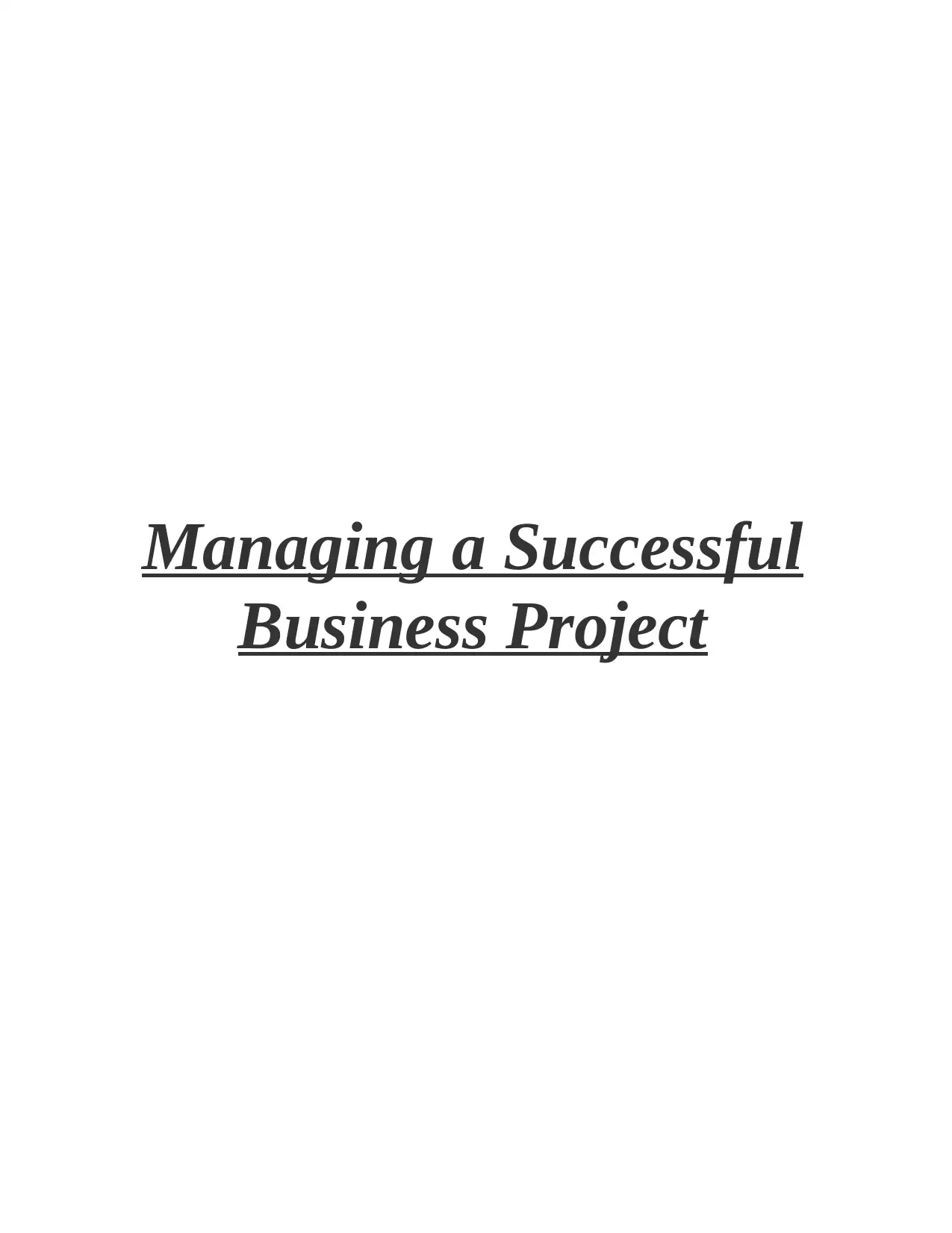
Managing a Successful
Business Project
Business Project
Paraphrase This Document
Need a fresh take? Get an instant paraphrase of this document with our AI Paraphraser
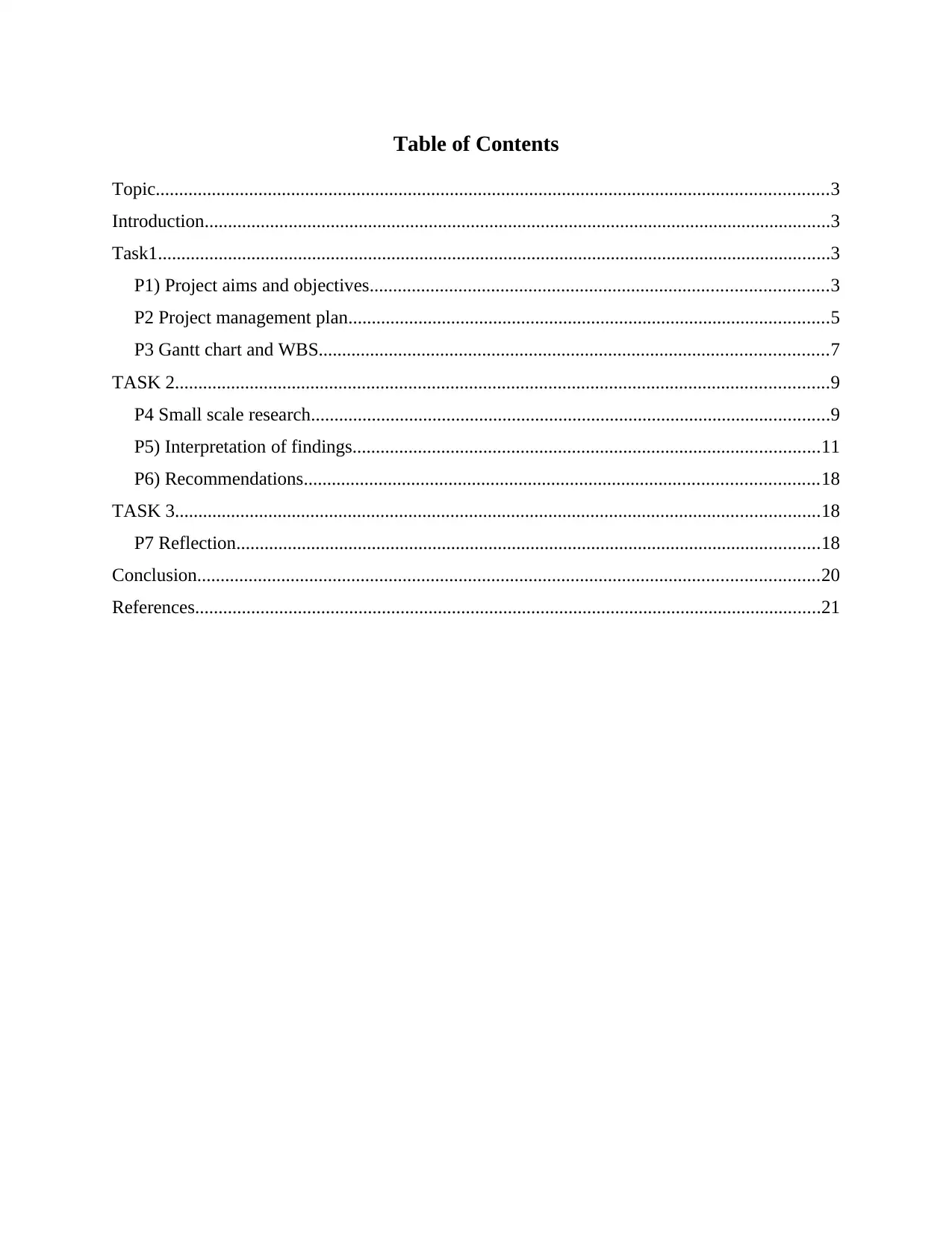
Table of Contents
Topic................................................................................................................................................3
Introduction......................................................................................................................................3
Task1................................................................................................................................................3
P1) Project aims and objectives..................................................................................................3
P2 Project management plan.......................................................................................................5
P3 Gantt chart and WBS.............................................................................................................7
TASK 2............................................................................................................................................9
P4 Small scale research...............................................................................................................9
P5) Interpretation of findings....................................................................................................11
P6) Recommendations..............................................................................................................18
TASK 3..........................................................................................................................................18
P7 Reflection.............................................................................................................................18
Conclusion.....................................................................................................................................20
References......................................................................................................................................21
Topic................................................................................................................................................3
Introduction......................................................................................................................................3
Task1................................................................................................................................................3
P1) Project aims and objectives..................................................................................................3
P2 Project management plan.......................................................................................................5
P3 Gantt chart and WBS.............................................................................................................7
TASK 2............................................................................................................................................9
P4 Small scale research...............................................................................................................9
P5) Interpretation of findings....................................................................................................11
P6) Recommendations..............................................................................................................18
TASK 3..........................................................................................................................................18
P7 Reflection.............................................................................................................................18
Conclusion.....................................................................................................................................20
References......................................................................................................................................21
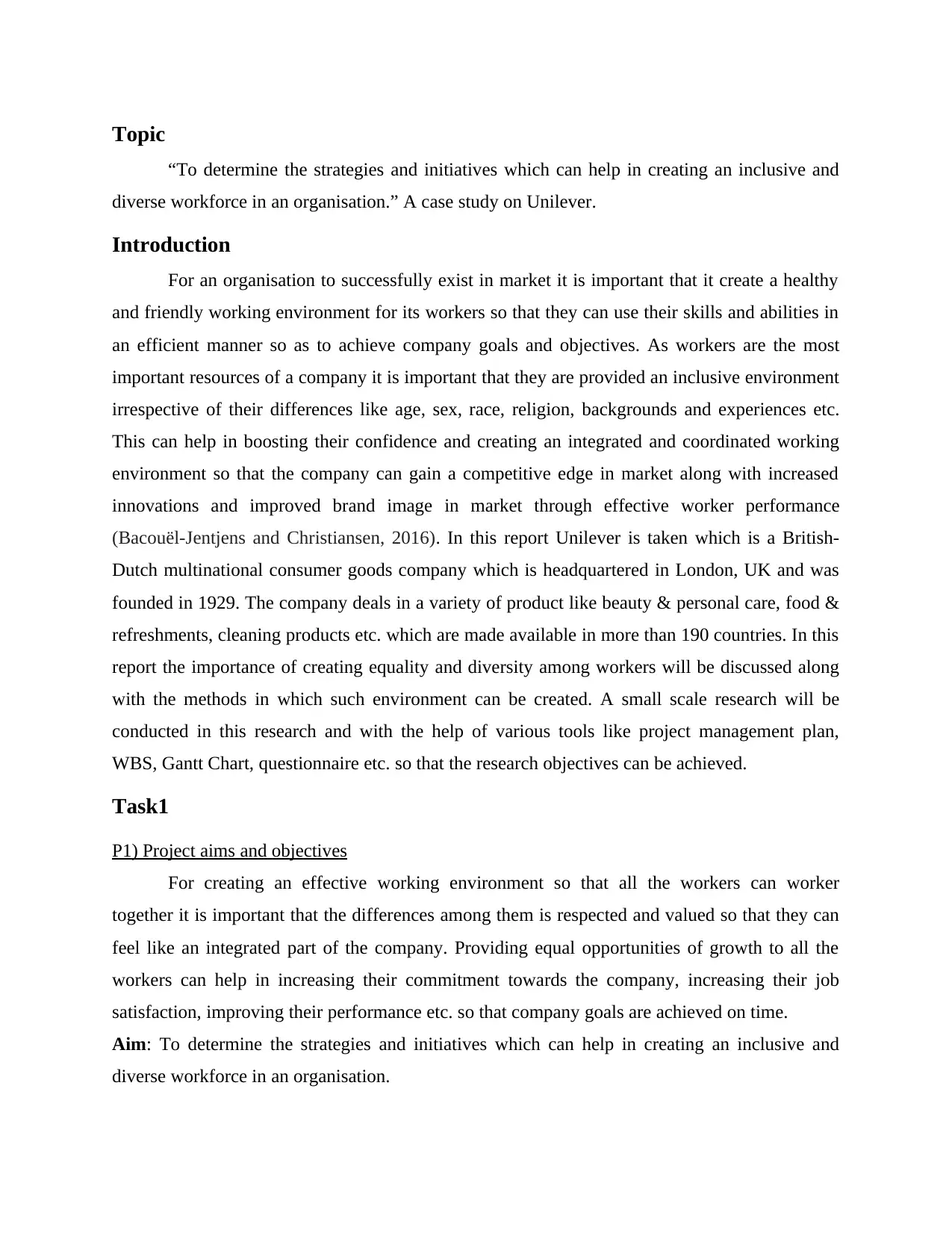
Topic
“To determine the strategies and initiatives which can help in creating an inclusive and
diverse workforce in an organisation.” A case study on Unilever.
Introduction
For an organisation to successfully exist in market it is important that it create a healthy
and friendly working environment for its workers so that they can use their skills and abilities in
an efficient manner so as to achieve company goals and objectives. As workers are the most
important resources of a company it is important that they are provided an inclusive environment
irrespective of their differences like age, sex, race, religion, backgrounds and experiences etc.
This can help in boosting their confidence and creating an integrated and coordinated working
environment so that the company can gain a competitive edge in market along with increased
innovations and improved brand image in market through effective worker performance
(Bacouël-Jentjens and Christiansen, 2016). In this report Unilever is taken which is a British-
Dutch multinational consumer goods company which is headquartered in London, UK and was
founded in 1929. The company deals in a variety of product like beauty & personal care, food &
refreshments, cleaning products etc. which are made available in more than 190 countries. In this
report the importance of creating equality and diversity among workers will be discussed along
with the methods in which such environment can be created. A small scale research will be
conducted in this research and with the help of various tools like project management plan,
WBS, Gantt Chart, questionnaire etc. so that the research objectives can be achieved.
Task1
P1) Project aims and objectives
For creating an effective working environment so that all the workers can worker
together it is important that the differences among them is respected and valued so that they can
feel like an integrated part of the company. Providing equal opportunities of growth to all the
workers can help in increasing their commitment towards the company, increasing their job
satisfaction, improving their performance etc. so that company goals are achieved on time.
Aim: To determine the strategies and initiatives which can help in creating an inclusive and
diverse workforce in an organisation.
“To determine the strategies and initiatives which can help in creating an inclusive and
diverse workforce in an organisation.” A case study on Unilever.
Introduction
For an organisation to successfully exist in market it is important that it create a healthy
and friendly working environment for its workers so that they can use their skills and abilities in
an efficient manner so as to achieve company goals and objectives. As workers are the most
important resources of a company it is important that they are provided an inclusive environment
irrespective of their differences like age, sex, race, religion, backgrounds and experiences etc.
This can help in boosting their confidence and creating an integrated and coordinated working
environment so that the company can gain a competitive edge in market along with increased
innovations and improved brand image in market through effective worker performance
(Bacouël-Jentjens and Christiansen, 2016). In this report Unilever is taken which is a British-
Dutch multinational consumer goods company which is headquartered in London, UK and was
founded in 1929. The company deals in a variety of product like beauty & personal care, food &
refreshments, cleaning products etc. which are made available in more than 190 countries. In this
report the importance of creating equality and diversity among workers will be discussed along
with the methods in which such environment can be created. A small scale research will be
conducted in this research and with the help of various tools like project management plan,
WBS, Gantt Chart, questionnaire etc. so that the research objectives can be achieved.
Task1
P1) Project aims and objectives
For creating an effective working environment so that all the workers can worker
together it is important that the differences among them is respected and valued so that they can
feel like an integrated part of the company. Providing equal opportunities of growth to all the
workers can help in increasing their commitment towards the company, increasing their job
satisfaction, improving their performance etc. so that company goals are achieved on time.
Aim: To determine the strategies and initiatives which can help in creating an inclusive and
diverse workforce in an organisation.
⊘ This is a preview!⊘
Do you want full access?
Subscribe today to unlock all pages.

Trusted by 1+ million students worldwide
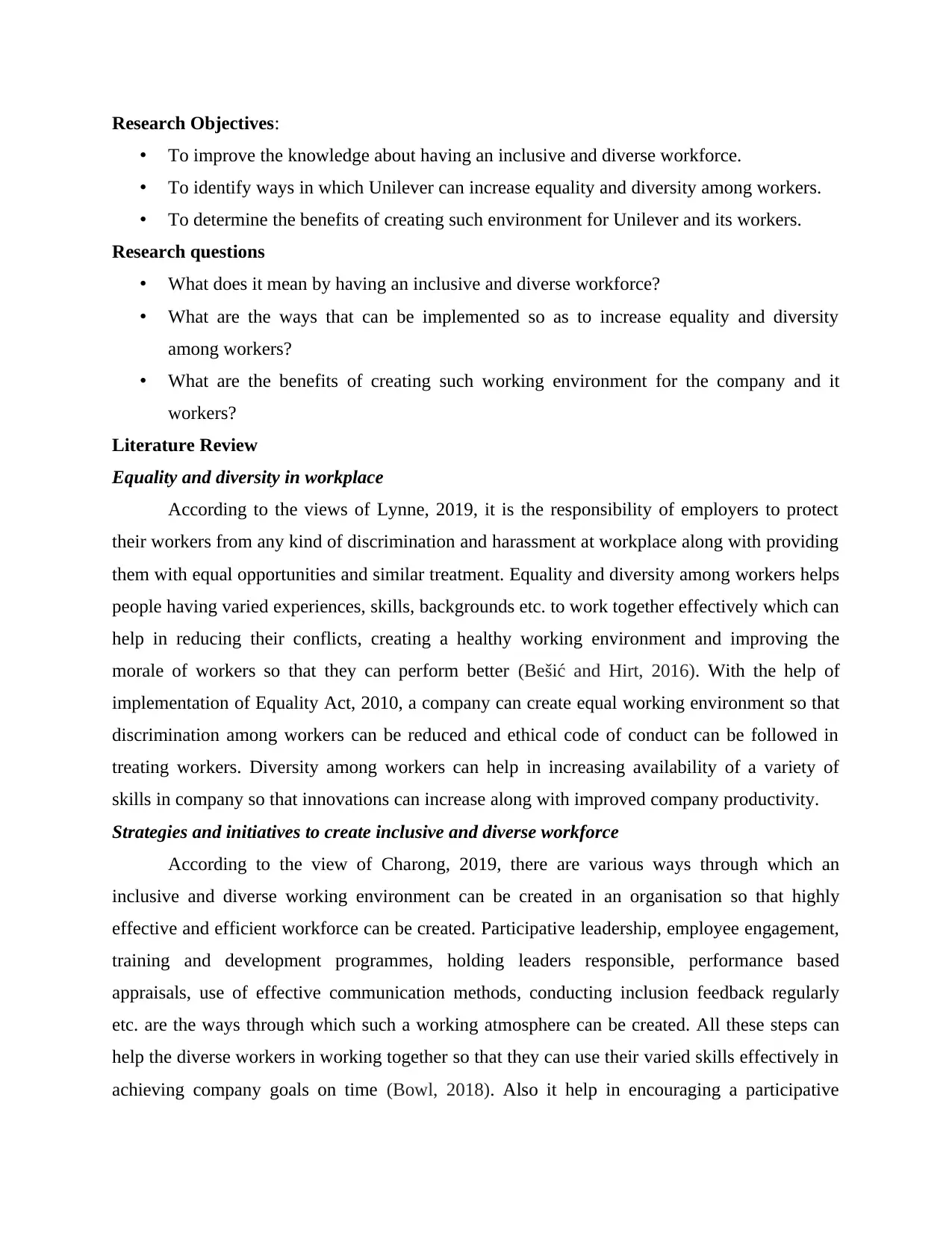
Research Objectives:
• To improve the knowledge about having an inclusive and diverse workforce.
• To identify ways in which Unilever can increase equality and diversity among workers.
• To determine the benefits of creating such environment for Unilever and its workers.
Research questions
• What does it mean by having an inclusive and diverse workforce?
• What are the ways that can be implemented so as to increase equality and diversity
among workers?
• What are the benefits of creating such working environment for the company and it
workers?
Literature Review
Equality and diversity in workplace
According to the views of Lynne, 2019, it is the responsibility of employers to protect
their workers from any kind of discrimination and harassment at workplace along with providing
them with equal opportunities and similar treatment. Equality and diversity among workers helps
people having varied experiences, skills, backgrounds etc. to work together effectively which can
help in reducing their conflicts, creating a healthy working environment and improving the
morale of workers so that they can perform better (Bešić and Hirt, 2016). With the help of
implementation of Equality Act, 2010, a company can create equal working environment so that
discrimination among workers can be reduced and ethical code of conduct can be followed in
treating workers. Diversity among workers can help in increasing availability of a variety of
skills in company so that innovations can increase along with improved company productivity.
Strategies and initiatives to create inclusive and diverse workforce
According to the view of Charong, 2019, there are various ways through which an
inclusive and diverse working environment can be created in an organisation so that highly
effective and efficient workforce can be created. Participative leadership, employee engagement,
training and development programmes, holding leaders responsible, performance based
appraisals, use of effective communication methods, conducting inclusion feedback regularly
etc. are the ways through which such a working atmosphere can be created. All these steps can
help the diverse workers in working together so that they can use their varied skills effectively in
achieving company goals on time (Bowl, 2018). Also it help in encouraging a participative
• To improve the knowledge about having an inclusive and diverse workforce.
• To identify ways in which Unilever can increase equality and diversity among workers.
• To determine the benefits of creating such environment for Unilever and its workers.
Research questions
• What does it mean by having an inclusive and diverse workforce?
• What are the ways that can be implemented so as to increase equality and diversity
among workers?
• What are the benefits of creating such working environment for the company and it
workers?
Literature Review
Equality and diversity in workplace
According to the views of Lynne, 2019, it is the responsibility of employers to protect
their workers from any kind of discrimination and harassment at workplace along with providing
them with equal opportunities and similar treatment. Equality and diversity among workers helps
people having varied experiences, skills, backgrounds etc. to work together effectively which can
help in reducing their conflicts, creating a healthy working environment and improving the
morale of workers so that they can perform better (Bešić and Hirt, 2016). With the help of
implementation of Equality Act, 2010, a company can create equal working environment so that
discrimination among workers can be reduced and ethical code of conduct can be followed in
treating workers. Diversity among workers can help in increasing availability of a variety of
skills in company so that innovations can increase along with improved company productivity.
Strategies and initiatives to create inclusive and diverse workforce
According to the view of Charong, 2019, there are various ways through which an
inclusive and diverse working environment can be created in an organisation so that highly
effective and efficient workforce can be created. Participative leadership, employee engagement,
training and development programmes, holding leaders responsible, performance based
appraisals, use of effective communication methods, conducting inclusion feedback regularly
etc. are the ways through which such a working atmosphere can be created. All these steps can
help the diverse workers in working together so that they can use their varied skills effectively in
achieving company goals on time (Bowl, 2018). Also it help in encouraging a participative
Paraphrase This Document
Need a fresh take? Get an instant paraphrase of this document with our AI Paraphraser
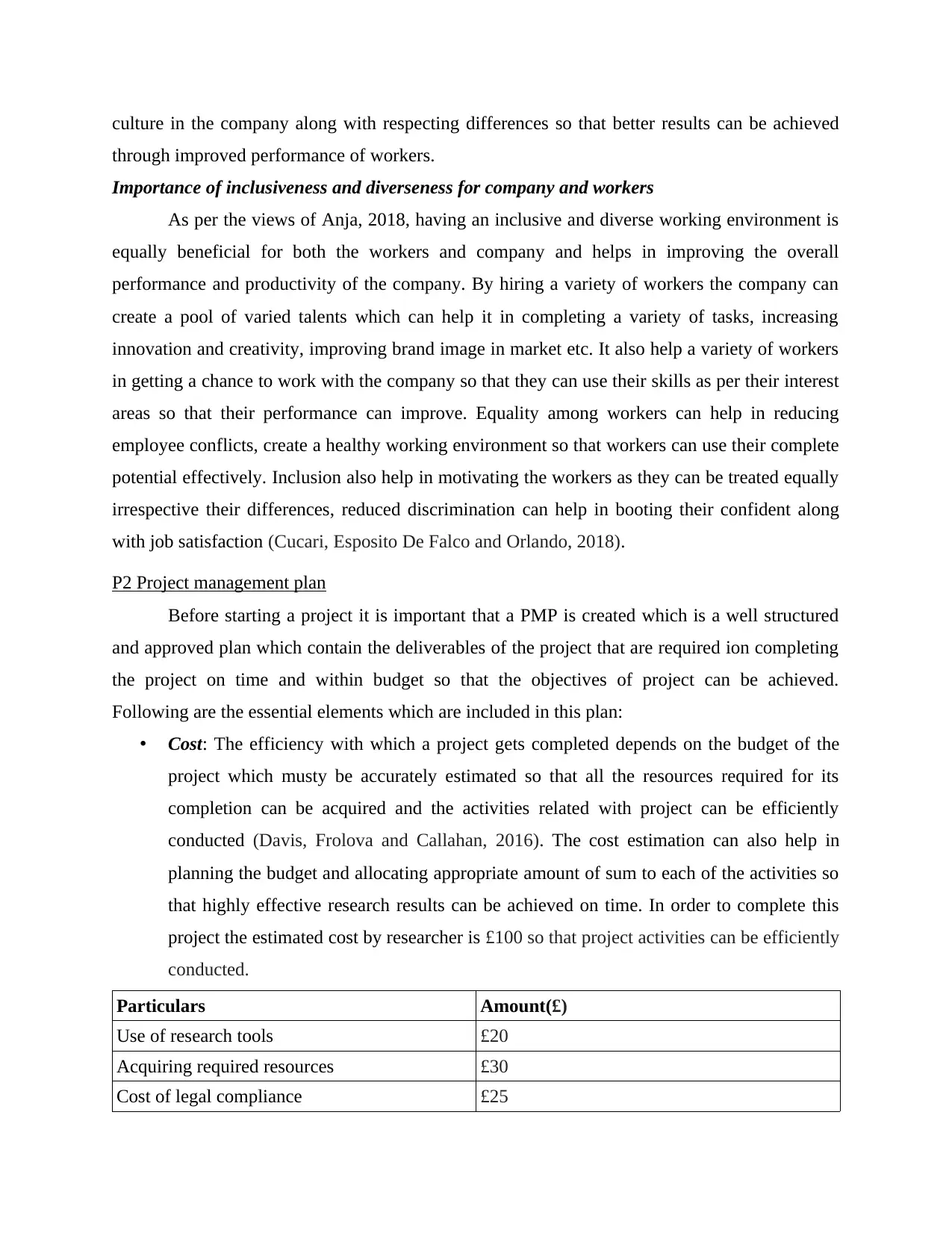
culture in the company along with respecting differences so that better results can be achieved
through improved performance of workers.
Importance of inclusiveness and diverseness for company and workers
As per the views of Anja, 2018, having an inclusive and diverse working environment is
equally beneficial for both the workers and company and helps in improving the overall
performance and productivity of the company. By hiring a variety of workers the company can
create a pool of varied talents which can help it in completing a variety of tasks, increasing
innovation and creativity, improving brand image in market etc. It also help a variety of workers
in getting a chance to work with the company so that they can use their skills as per their interest
areas so that their performance can improve. Equality among workers can help in reducing
employee conflicts, create a healthy working environment so that workers can use their complete
potential effectively. Inclusion also help in motivating the workers as they can be treated equally
irrespective their differences, reduced discrimination can help in booting their confident along
with job satisfaction (Cucari, Esposito De Falco and Orlando, 2018).
P2 Project management plan
Before starting a project it is important that a PMP is created which is a well structured
and approved plan which contain the deliverables of the project that are required ion completing
the project on time and within budget so that the objectives of project can be achieved.
Following are the essential elements which are included in this plan:
• Cost: The efficiency with which a project gets completed depends on the budget of the
project which musty be accurately estimated so that all the resources required for its
completion can be acquired and the activities related with project can be efficiently
conducted (Davis, Frolova and Callahan, 2016). The cost estimation can also help in
planning the budget and allocating appropriate amount of sum to each of the activities so
that highly effective research results can be achieved on time. In order to complete this
project the estimated cost by researcher is £100 so that project activities can be efficiently
conducted.
Particulars Amount(£)
Use of research tools £20
Acquiring required resources £30
Cost of legal compliance £25
through improved performance of workers.
Importance of inclusiveness and diverseness for company and workers
As per the views of Anja, 2018, having an inclusive and diverse working environment is
equally beneficial for both the workers and company and helps in improving the overall
performance and productivity of the company. By hiring a variety of workers the company can
create a pool of varied talents which can help it in completing a variety of tasks, increasing
innovation and creativity, improving brand image in market etc. It also help a variety of workers
in getting a chance to work with the company so that they can use their skills as per their interest
areas so that their performance can improve. Equality among workers can help in reducing
employee conflicts, create a healthy working environment so that workers can use their complete
potential effectively. Inclusion also help in motivating the workers as they can be treated equally
irrespective their differences, reduced discrimination can help in booting their confident along
with job satisfaction (Cucari, Esposito De Falco and Orlando, 2018).
P2 Project management plan
Before starting a project it is important that a PMP is created which is a well structured
and approved plan which contain the deliverables of the project that are required ion completing
the project on time and within budget so that the objectives of project can be achieved.
Following are the essential elements which are included in this plan:
• Cost: The efficiency with which a project gets completed depends on the budget of the
project which musty be accurately estimated so that all the resources required for its
completion can be acquired and the activities related with project can be efficiently
conducted (Davis, Frolova and Callahan, 2016). The cost estimation can also help in
planning the budget and allocating appropriate amount of sum to each of the activities so
that highly effective research results can be achieved on time. In order to complete this
project the estimated cost by researcher is £100 so that project activities can be efficiently
conducted.
Particulars Amount(£)
Use of research tools £20
Acquiring required resources £30
Cost of legal compliance £25
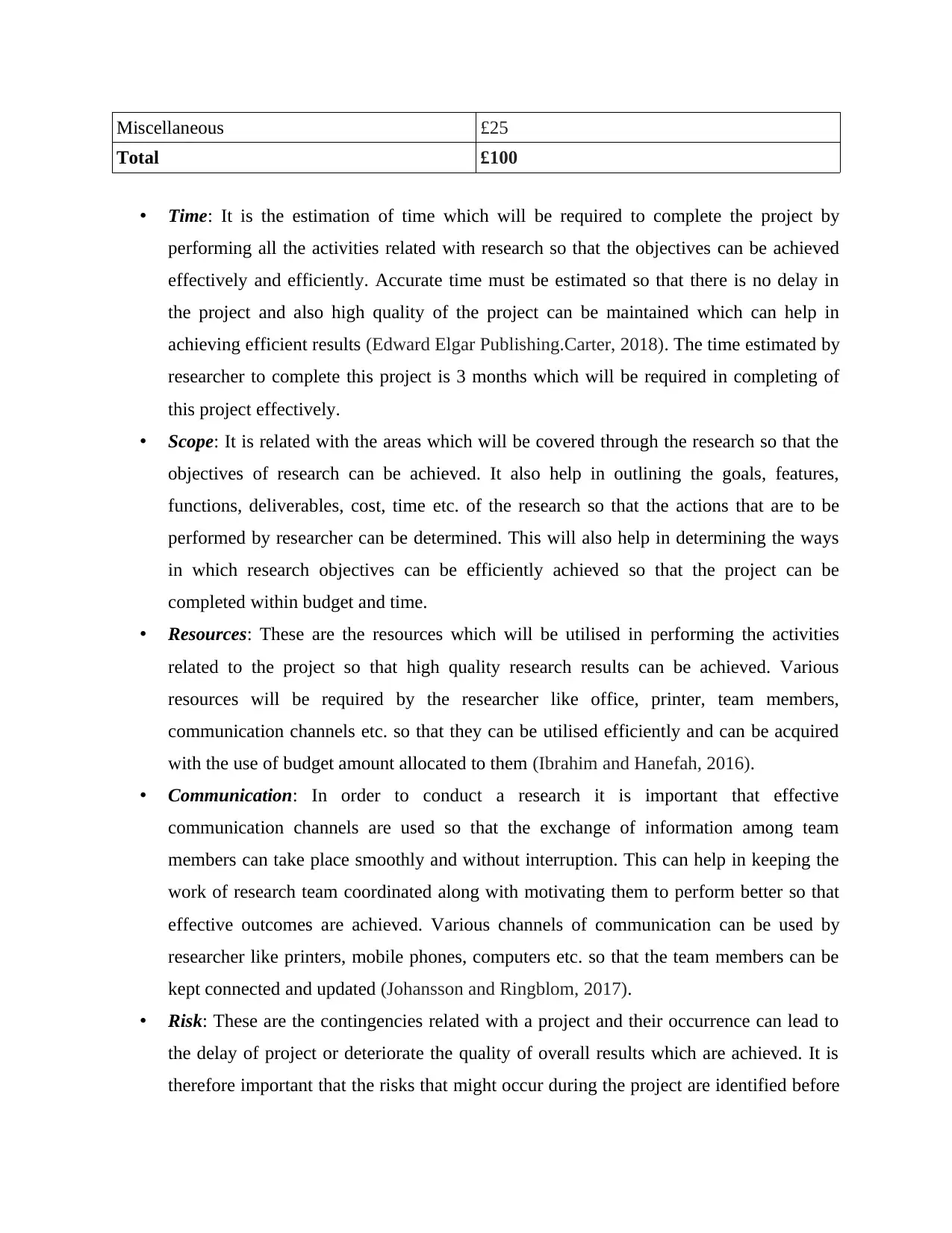
Miscellaneous £25
Total £100
• Time: It is the estimation of time which will be required to complete the project by
performing all the activities related with research so that the objectives can be achieved
effectively and efficiently. Accurate time must be estimated so that there is no delay in
the project and also high quality of the project can be maintained which can help in
achieving efficient results (Edward Elgar Publishing.Carter, 2018). The time estimated by
researcher to complete this project is 3 months which will be required in completing of
this project effectively.
• Scope: It is related with the areas which will be covered through the research so that the
objectives of research can be achieved. It also help in outlining the goals, features,
functions, deliverables, cost, time etc. of the research so that the actions that are to be
performed by researcher can be determined. This will also help in determining the ways
in which research objectives can be efficiently achieved so that the project can be
completed within budget and time.
• Resources: These are the resources which will be utilised in performing the activities
related to the project so that high quality research results can be achieved. Various
resources will be required by the researcher like office, printer, team members,
communication channels etc. so that they can be utilised efficiently and can be acquired
with the use of budget amount allocated to them (Ibrahim and Hanefah, 2016).
• Communication: In order to conduct a research it is important that effective
communication channels are used so that the exchange of information among team
members can take place smoothly and without interruption. This can help in keeping the
work of research team coordinated along with motivating them to perform better so that
effective outcomes are achieved. Various channels of communication can be used by
researcher like printers, mobile phones, computers etc. so that the team members can be
kept connected and updated (Johansson and Ringblom, 2017).
• Risk: These are the contingencies related with a project and their occurrence can lead to
the delay of project or deteriorate the quality of overall results which are achieved. It is
therefore important that the risks that might occur during the project are identified before
Total £100
• Time: It is the estimation of time which will be required to complete the project by
performing all the activities related with research so that the objectives can be achieved
effectively and efficiently. Accurate time must be estimated so that there is no delay in
the project and also high quality of the project can be maintained which can help in
achieving efficient results (Edward Elgar Publishing.Carter, 2018). The time estimated by
researcher to complete this project is 3 months which will be required in completing of
this project effectively.
• Scope: It is related with the areas which will be covered through the research so that the
objectives of research can be achieved. It also help in outlining the goals, features,
functions, deliverables, cost, time etc. of the research so that the actions that are to be
performed by researcher can be determined. This will also help in determining the ways
in which research objectives can be efficiently achieved so that the project can be
completed within budget and time.
• Resources: These are the resources which will be utilised in performing the activities
related to the project so that high quality research results can be achieved. Various
resources will be required by the researcher like office, printer, team members,
communication channels etc. so that they can be utilised efficiently and can be acquired
with the use of budget amount allocated to them (Ibrahim and Hanefah, 2016).
• Communication: In order to conduct a research it is important that effective
communication channels are used so that the exchange of information among team
members can take place smoothly and without interruption. This can help in keeping the
work of research team coordinated along with motivating them to perform better so that
effective outcomes are achieved. Various channels of communication can be used by
researcher like printers, mobile phones, computers etc. so that the team members can be
kept connected and updated (Johansson and Ringblom, 2017).
• Risk: These are the contingencies related with a project and their occurrence can lead to
the delay of project or deteriorate the quality of overall results which are achieved. It is
therefore important that the risks that might occur during the project are identified before
⊘ This is a preview!⊘
Do you want full access?
Subscribe today to unlock all pages.

Trusted by 1+ million students worldwide
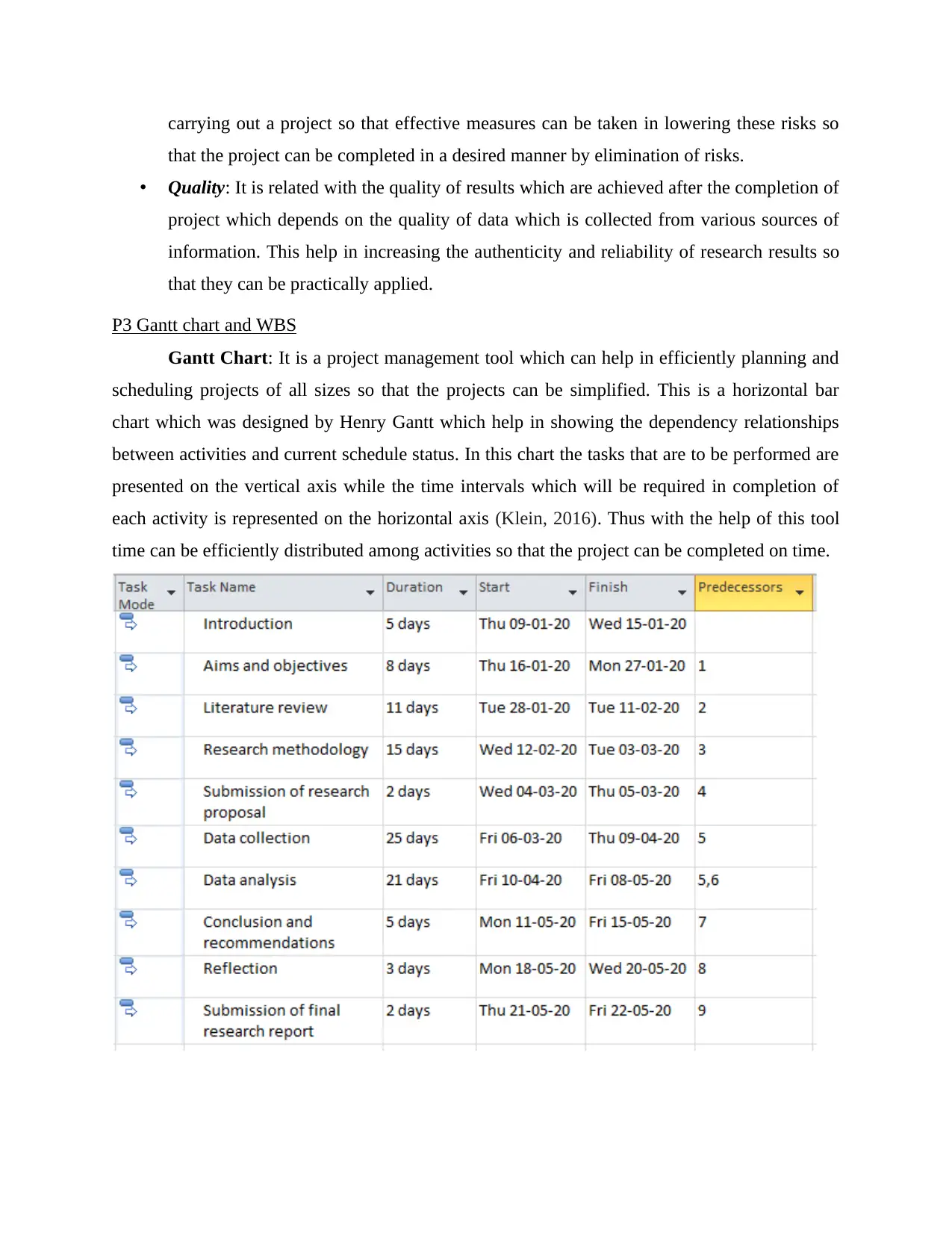
carrying out a project so that effective measures can be taken in lowering these risks so
that the project can be completed in a desired manner by elimination of risks.
• Quality: It is related with the quality of results which are achieved after the completion of
project which depends on the quality of data which is collected from various sources of
information. This help in increasing the authenticity and reliability of research results so
that they can be practically applied.
P3 Gantt chart and WBS
Gantt Chart: It is a project management tool which can help in efficiently planning and
scheduling projects of all sizes so that the projects can be simplified. This is a horizontal bar
chart which was designed by Henry Gantt which help in showing the dependency relationships
between activities and current schedule status. In this chart the tasks that are to be performed are
presented on the vertical axis while the time intervals which will be required in completion of
each activity is represented on the horizontal axis (Klein, 2016). Thus with the help of this tool
time can be efficiently distributed among activities so that the project can be completed on time.
that the project can be completed in a desired manner by elimination of risks.
• Quality: It is related with the quality of results which are achieved after the completion of
project which depends on the quality of data which is collected from various sources of
information. This help in increasing the authenticity and reliability of research results so
that they can be practically applied.
P3 Gantt chart and WBS
Gantt Chart: It is a project management tool which can help in efficiently planning and
scheduling projects of all sizes so that the projects can be simplified. This is a horizontal bar
chart which was designed by Henry Gantt which help in showing the dependency relationships
between activities and current schedule status. In this chart the tasks that are to be performed are
presented on the vertical axis while the time intervals which will be required in completion of
each activity is represented on the horizontal axis (Klein, 2016). Thus with the help of this tool
time can be efficiently distributed among activities so that the project can be completed on time.
Paraphrase This Document
Need a fresh take? Get an instant paraphrase of this document with our AI Paraphraser
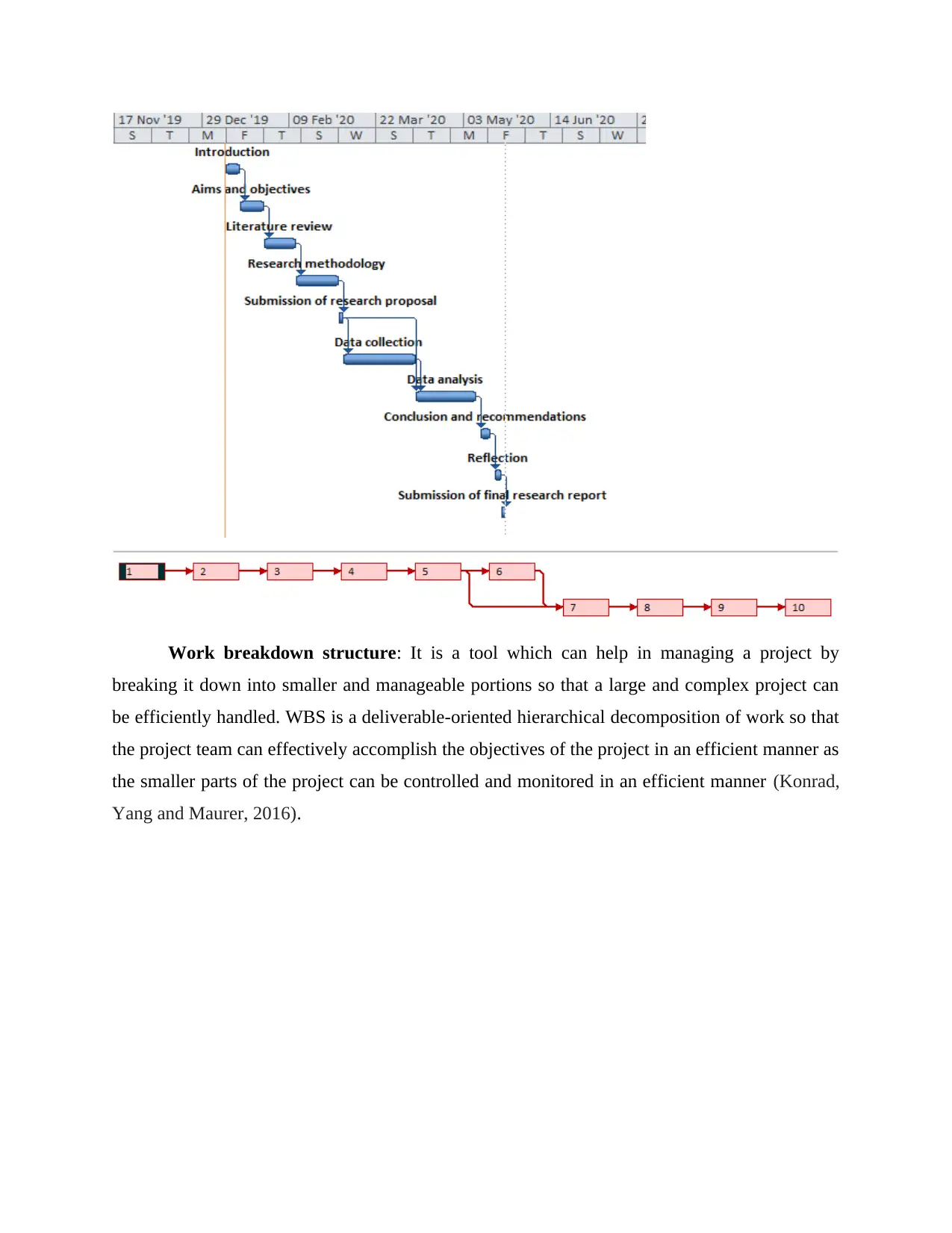
Work breakdown structure: It is a tool which can help in managing a project by
breaking it down into smaller and manageable portions so that a large and complex project can
be efficiently handled. WBS is a deliverable-oriented hierarchical decomposition of work so that
the project team can effectively accomplish the objectives of the project in an efficient manner as
the smaller parts of the project can be controlled and monitored in an efficient manner (Konrad,
Yang and Maurer, 2016).
breaking it down into smaller and manageable portions so that a large and complex project can
be efficiently handled. WBS is a deliverable-oriented hierarchical decomposition of work so that
the project team can effectively accomplish the objectives of the project in an efficient manner as
the smaller parts of the project can be controlled and monitored in an efficient manner (Konrad,
Yang and Maurer, 2016).
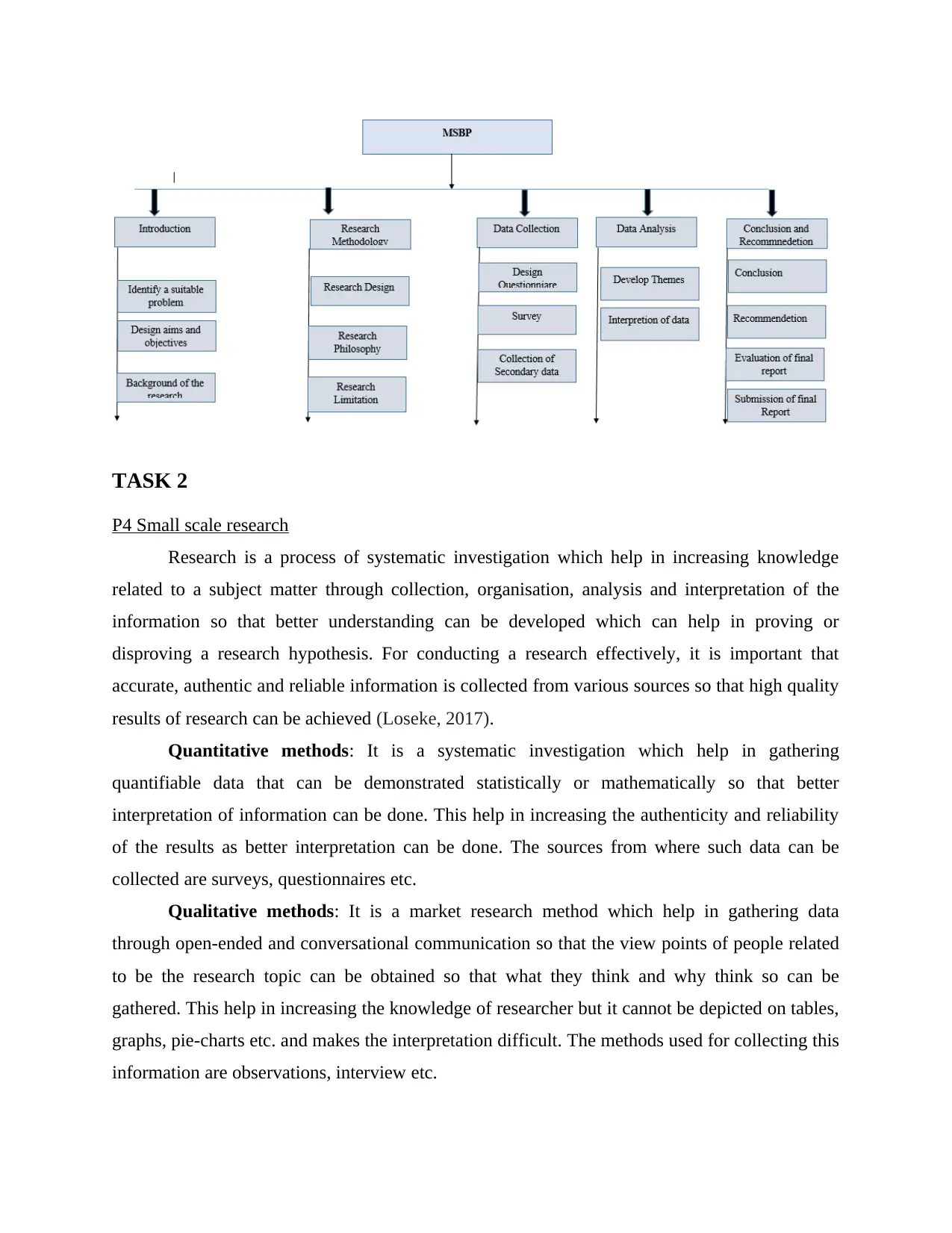
TASK 2
P4 Small scale research
Research is a process of systematic investigation which help in increasing knowledge
related to a subject matter through collection, organisation, analysis and interpretation of the
information so that better understanding can be developed which can help in proving or
disproving a research hypothesis. For conducting a research effectively, it is important that
accurate, authentic and reliable information is collected from various sources so that high quality
results of research can be achieved (Loseke, 2017).
Quantitative methods: It is a systematic investigation which help in gathering
quantifiable data that can be demonstrated statistically or mathematically so that better
interpretation of information can be done. This help in increasing the authenticity and reliability
of the results as better interpretation can be done. The sources from where such data can be
collected are surveys, questionnaires etc.
Qualitative methods: It is a market research method which help in gathering data
through open-ended and conversational communication so that the view points of people related
to be the research topic can be obtained so that what they think and why think so can be
gathered. This help in increasing the knowledge of researcher but it cannot be depicted on tables,
graphs, pie-charts etc. and makes the interpretation difficult. The methods used for collecting this
information are observations, interview etc.
P4 Small scale research
Research is a process of systematic investigation which help in increasing knowledge
related to a subject matter through collection, organisation, analysis and interpretation of the
information so that better understanding can be developed which can help in proving or
disproving a research hypothesis. For conducting a research effectively, it is important that
accurate, authentic and reliable information is collected from various sources so that high quality
results of research can be achieved (Loseke, 2017).
Quantitative methods: It is a systematic investigation which help in gathering
quantifiable data that can be demonstrated statistically or mathematically so that better
interpretation of information can be done. This help in increasing the authenticity and reliability
of the results as better interpretation can be done. The sources from where such data can be
collected are surveys, questionnaires etc.
Qualitative methods: It is a market research method which help in gathering data
through open-ended and conversational communication so that the view points of people related
to be the research topic can be obtained so that what they think and why think so can be
gathered. This help in increasing the knowledge of researcher but it cannot be depicted on tables,
graphs, pie-charts etc. and makes the interpretation difficult. The methods used for collecting this
information are observations, interview etc.
⊘ This is a preview!⊘
Do you want full access?
Subscribe today to unlock all pages.

Trusted by 1+ million students worldwide
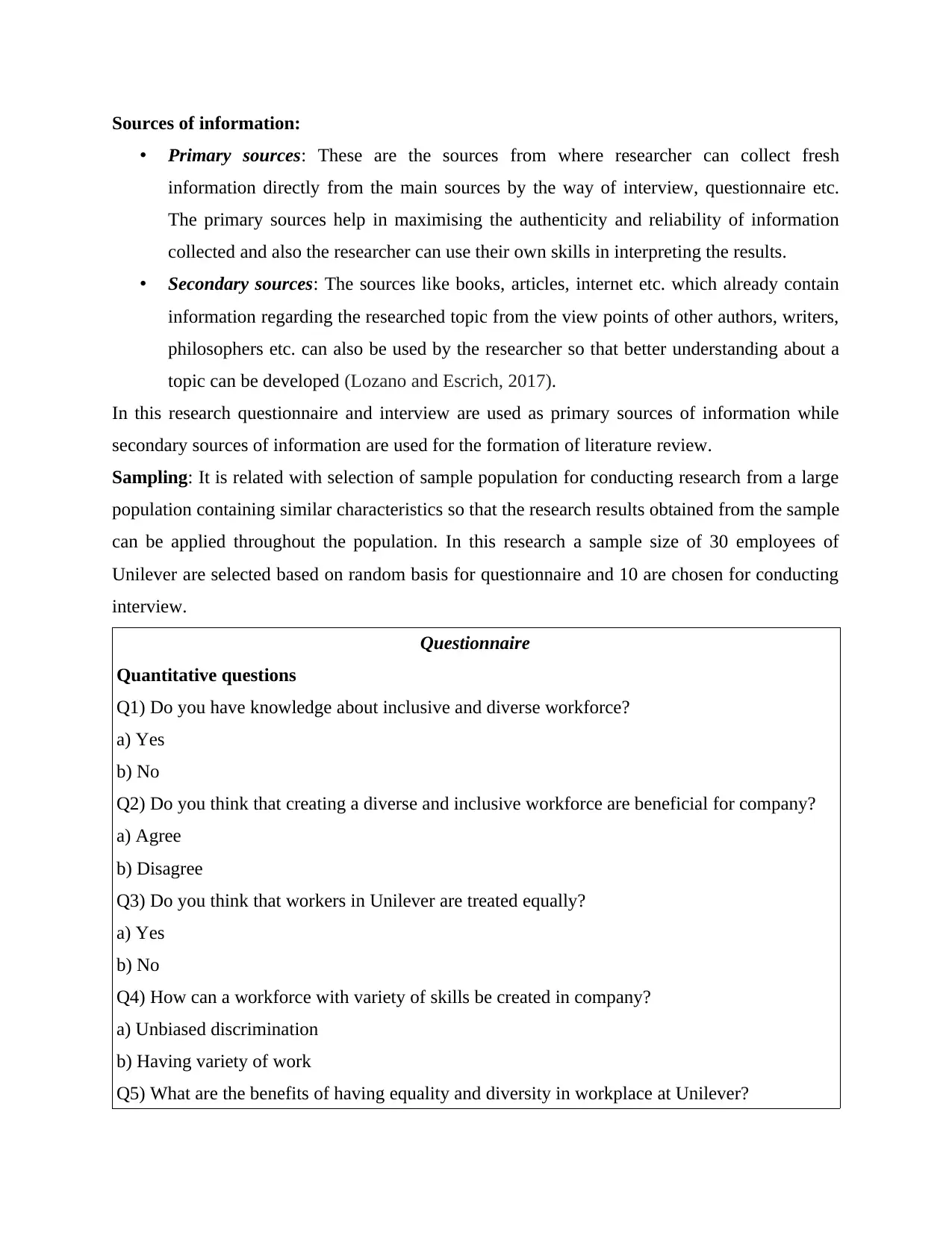
Sources of information:
• Primary sources: These are the sources from where researcher can collect fresh
information directly from the main sources by the way of interview, questionnaire etc.
The primary sources help in maximising the authenticity and reliability of information
collected and also the researcher can use their own skills in interpreting the results.
• Secondary sources: The sources like books, articles, internet etc. which already contain
information regarding the researched topic from the view points of other authors, writers,
philosophers etc. can also be used by the researcher so that better understanding about a
topic can be developed (Lozano and Escrich, 2017).
In this research questionnaire and interview are used as primary sources of information while
secondary sources of information are used for the formation of literature review.
Sampling: It is related with selection of sample population for conducting research from a large
population containing similar characteristics so that the research results obtained from the sample
can be applied throughout the population. In this research a sample size of 30 employees of
Unilever are selected based on random basis for questionnaire and 10 are chosen for conducting
interview.
Questionnaire
Quantitative questions
Q1) Do you have knowledge about inclusive and diverse workforce?
a) Yes
b) No
Q2) Do you think that creating a diverse and inclusive workforce are beneficial for company?
a) Agree
b) Disagree
Q3) Do you think that workers in Unilever are treated equally?
a) Yes
b) No
Q4) How can a workforce with variety of skills be created in company?
a) Unbiased discrimination
b) Having variety of work
Q5) What are the benefits of having equality and diversity in workplace at Unilever?
• Primary sources: These are the sources from where researcher can collect fresh
information directly from the main sources by the way of interview, questionnaire etc.
The primary sources help in maximising the authenticity and reliability of information
collected and also the researcher can use their own skills in interpreting the results.
• Secondary sources: The sources like books, articles, internet etc. which already contain
information regarding the researched topic from the view points of other authors, writers,
philosophers etc. can also be used by the researcher so that better understanding about a
topic can be developed (Lozano and Escrich, 2017).
In this research questionnaire and interview are used as primary sources of information while
secondary sources of information are used for the formation of literature review.
Sampling: It is related with selection of sample population for conducting research from a large
population containing similar characteristics so that the research results obtained from the sample
can be applied throughout the population. In this research a sample size of 30 employees of
Unilever are selected based on random basis for questionnaire and 10 are chosen for conducting
interview.
Questionnaire
Quantitative questions
Q1) Do you have knowledge about inclusive and diverse workforce?
a) Yes
b) No
Q2) Do you think that creating a diverse and inclusive workforce are beneficial for company?
a) Agree
b) Disagree
Q3) Do you think that workers in Unilever are treated equally?
a) Yes
b) No
Q4) How can a workforce with variety of skills be created in company?
a) Unbiased discrimination
b) Having variety of work
Q5) What are the benefits of having equality and diversity in workplace at Unilever?
Paraphrase This Document
Need a fresh take? Get an instant paraphrase of this document with our AI Paraphraser
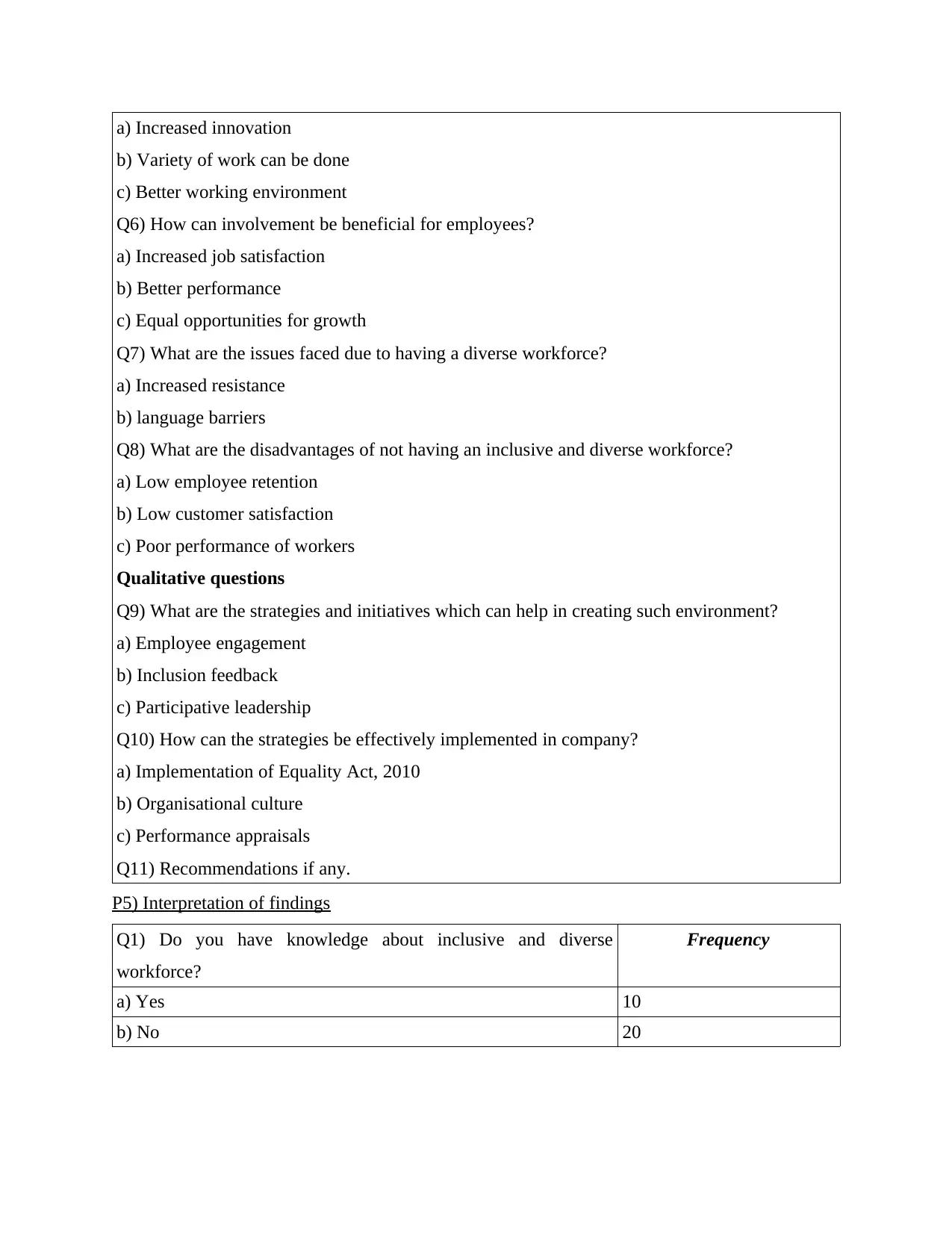
a) Increased innovation
b) Variety of work can be done
c) Better working environment
Q6) How can involvement be beneficial for employees?
a) Increased job satisfaction
b) Better performance
c) Equal opportunities for growth
Q7) What are the issues faced due to having a diverse workforce?
a) Increased resistance
b) language barriers
Q8) What are the disadvantages of not having an inclusive and diverse workforce?
a) Low employee retention
b) Low customer satisfaction
c) Poor performance of workers
Qualitative questions
Q9) What are the strategies and initiatives which can help in creating such environment?
a) Employee engagement
b) Inclusion feedback
c) Participative leadership
Q10) How can the strategies be effectively implemented in company?
a) Implementation of Equality Act, 2010
b) Organisational culture
c) Performance appraisals
Q11) Recommendations if any.
P5) Interpretation of findings
Q1) Do you have knowledge about inclusive and diverse
workforce?
Frequency
a) Yes 10
b) No 20
b) Variety of work can be done
c) Better working environment
Q6) How can involvement be beneficial for employees?
a) Increased job satisfaction
b) Better performance
c) Equal opportunities for growth
Q7) What are the issues faced due to having a diverse workforce?
a) Increased resistance
b) language barriers
Q8) What are the disadvantages of not having an inclusive and diverse workforce?
a) Low employee retention
b) Low customer satisfaction
c) Poor performance of workers
Qualitative questions
Q9) What are the strategies and initiatives which can help in creating such environment?
a) Employee engagement
b) Inclusion feedback
c) Participative leadership
Q10) How can the strategies be effectively implemented in company?
a) Implementation of Equality Act, 2010
b) Organisational culture
c) Performance appraisals
Q11) Recommendations if any.
P5) Interpretation of findings
Q1) Do you have knowledge about inclusive and diverse
workforce?
Frequency
a) Yes 10
b) No 20
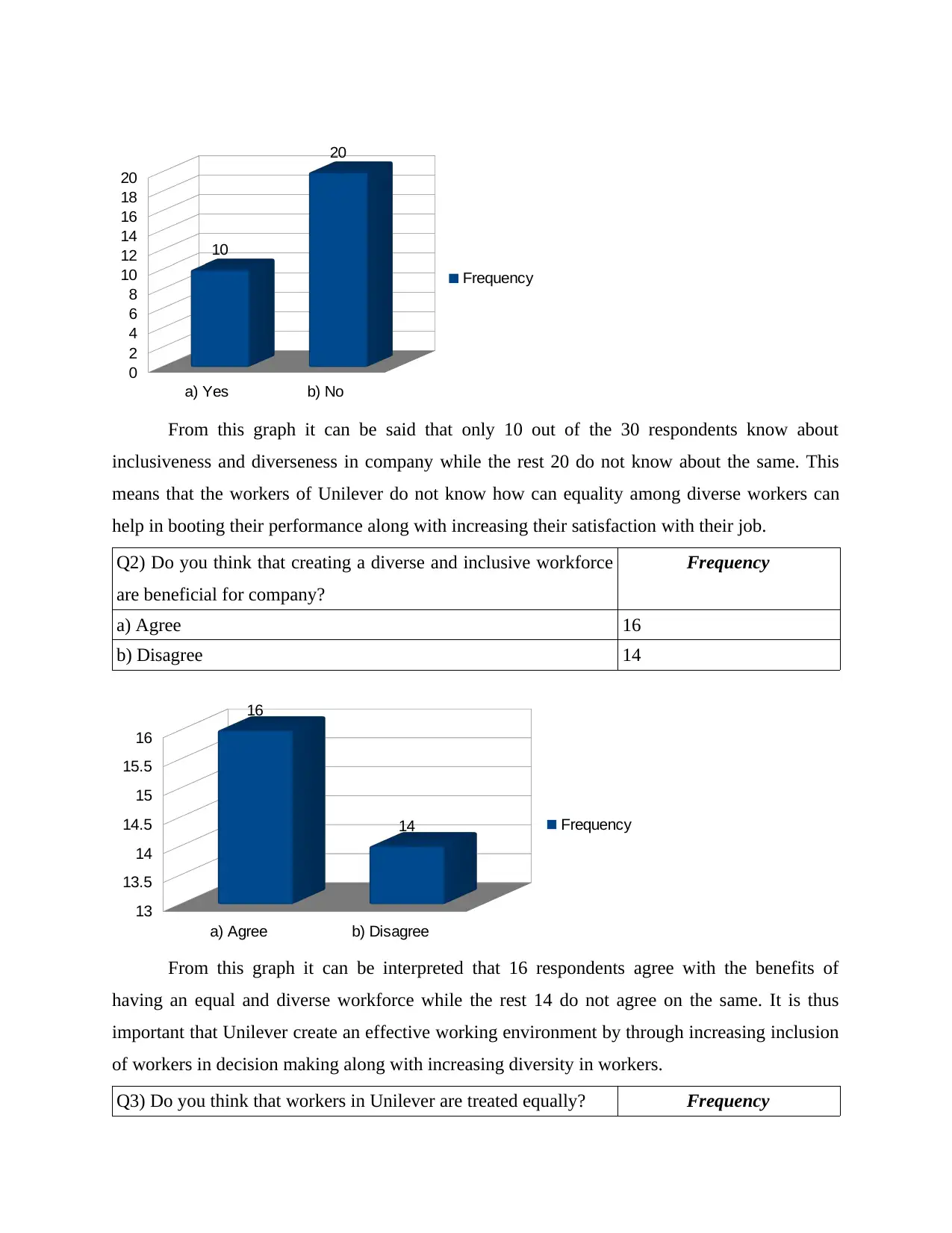
a) Yes b) No
0
2
4
6
8
10
12
14
16
18
20
10
20
Frequency
From this graph it can be said that only 10 out of the 30 respondents know about
inclusiveness and diverseness in company while the rest 20 do not know about the same. This
means that the workers of Unilever do not know how can equality among diverse workers can
help in booting their performance along with increasing their satisfaction with their job.
Q2) Do you think that creating a diverse and inclusive workforce
are beneficial for company?
Frequency
a) Agree 16
b) Disagree 14
a) Agree b) Disagree
13
13.5
14
14.5
15
15.5
16
16
14 Frequency
From this graph it can be interpreted that 16 respondents agree with the benefits of
having an equal and diverse workforce while the rest 14 do not agree on the same. It is thus
important that Unilever create an effective working environment by through increasing inclusion
of workers in decision making along with increasing diversity in workers.
Q3) Do you think that workers in Unilever are treated equally? Frequency
0
2
4
6
8
10
12
14
16
18
20
10
20
Frequency
From this graph it can be said that only 10 out of the 30 respondents know about
inclusiveness and diverseness in company while the rest 20 do not know about the same. This
means that the workers of Unilever do not know how can equality among diverse workers can
help in booting their performance along with increasing their satisfaction with their job.
Q2) Do you think that creating a diverse and inclusive workforce
are beneficial for company?
Frequency
a) Agree 16
b) Disagree 14
a) Agree b) Disagree
13
13.5
14
14.5
15
15.5
16
16
14 Frequency
From this graph it can be interpreted that 16 respondents agree with the benefits of
having an equal and diverse workforce while the rest 14 do not agree on the same. It is thus
important that Unilever create an effective working environment by through increasing inclusion
of workers in decision making along with increasing diversity in workers.
Q3) Do you think that workers in Unilever are treated equally? Frequency
⊘ This is a preview!⊘
Do you want full access?
Subscribe today to unlock all pages.

Trusted by 1+ million students worldwide
1 out of 25
Related Documents
Your All-in-One AI-Powered Toolkit for Academic Success.
+13062052269
info@desklib.com
Available 24*7 on WhatsApp / Email
![[object Object]](/_next/static/media/star-bottom.7253800d.svg)
Unlock your academic potential
Copyright © 2020–2025 A2Z Services. All Rights Reserved. Developed and managed by ZUCOL.





